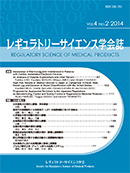Volume 11, Issue 1
Displaying 1-9 of 9 articles from this issue
- |<
- <
- 1
- >
- >|
-
2021Volume 11Issue 1 Pages 1-2
Published: 2021
Released on J-STAGE: January 31, 2021
Download PDF (157K)
Original Article
-
2021Volume 11Issue 1 Pages 3-12
Published: 2021
Released on J-STAGE: January 31, 2021
Download PDF (483K)
-
2021Volume 11Issue 1 Pages 13-25
Published: 2021
Released on J-STAGE: January 31, 2021
Download PDF (1222K) -
2021Volume 11Issue 1 Pages 27-41
Published: 2021
Released on J-STAGE: January 31, 2021
Download PDF (456K)
-
2021Volume 11Issue 1 Pages 43-51
Published: 2021
Released on J-STAGE: January 31, 2021
Download PDF (1844K) -
2021Volume 11Issue 1 Pages 53-61
Published: 2021
Released on J-STAGE: January 31, 2021
Download PDF (470K) -
2021Volume 11Issue 1 Pages 63-74
Published: 2021
Released on J-STAGE: January 31, 2021
Download PDF (1198K) -
2021Volume 11Issue 1 Pages 75-81
Published: 2021
Released on J-STAGE: January 31, 2021
Download PDF (471K)
-
2021Volume 11Issue 1 Pages 83-90
Published: 2021
Released on J-STAGE: January 31, 2021
Download PDF (353K)
- |<
- <
- 1
- >
- >|
